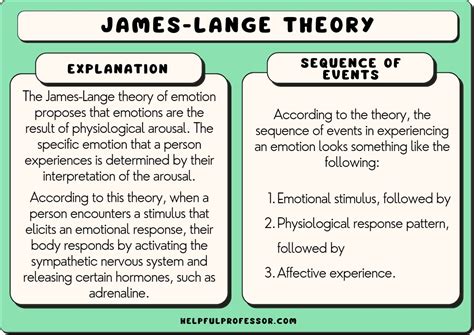Introduction: Delving into the Neural Foundations of Emotion
The James-Lange Theory of Emotion, proposed by physiologists William James and Carl Lange, is a seminal theory in psychology that posits a causal relationship between physiological responses and subjective emotional experiences. This theory challenges the traditional view that emotions precede and trigger physiological reactions.

Key Concepts of the James-Lange Theory
According to the James-Lange Theory, emotions arise from the perception and interpretation of physiological changes occurring in the body. These changes, such as increased heart rate, sweating, or trembling, are triggered by external stimuli and elicit specific emotional states.
Empirical Support for the James-Lange Theory
Numerous studies have provided empirical support for the James-Lange Theory. One study conducted by Cannon and Bard (1927) found that severance of the spinal cord, which disrupts the communication between the body and brain, did not eliminate emotional experiences.
Another study by Schachter and Singer (1962) demonstrated that the injection of epinephrine, which induces physiological changes similar to those associated with fear, produced a variety of emotional reactions depending on the context in which the injection was administered.
Criticisms and Refinements of the James-Lange Theory
While the James-Lange Theory has been widely influential, it has also faced criticism. One critique is that it fails to account for emotions that do not involve noticeable physiological changes, such as pride or guilt.
Furthermore, research suggests that emotions and physiological responses are not always linearly related. In some cases, physiological changes may precede emotional experiences, while in others, emotions may precede physiological changes.
In response to these criticisms, researchers have proposed refinements to the James-Lange Theory. One such refinement is the Cannon-Bard Theory, which posits that emotions and physiological responses occur simultaneously and independently of each other.
Contemporary Applications of the James-Lange Theory
The James-Lange Theory remains a valuable framework for understanding the neural basis of emotion. It has informed research in various fields, including:
Neuroscience: The theory has guided studies on the role of specific brain regions, such as the amygdala and insula, in emotion processing.
Clinical Psychology: The theory has been applied to the treatment of emotional disorders, such as anxiety and depression, by targeting physiological responses associated with these conditions.
Educational Psychology: The theory has been used to understand the impact of emotions on learning and memory by investigating the physiological responses associated with different emotional states.
Common Mistakes to Avoid in Applying the James-Lange Theory
To avoid misinterpretations and ensure proper application of the James-Lange Theory, it is crucial to keep the following in mind:
- Do not overgeneralize: The theory does not account for all emotions or situations.
- Consider contextual factors: The interpretation of physiological responses depends on the context in which they occur.
- Acknowledge individual differences: The relationship between physiological responses and emotions can vary across individuals.
Facilitating Emotional Intelligence: Practical Implications
The James-Lange Theory provides practical insights for enhancing emotional intelligence. By recognizing the role of physiological responses in emotion, individuals can:
- Identify emotions: Pay attention to bodily cues associated with different emotions to better understand their feelings.
- Manage emotions: Use techniques such as deep breathing or meditation to regulate physiological responses and influence emotional experiences.
- Empathize with others: Observe and interpret physiological cues to better understand the emotions of others.
Conclusion: Embracing the Body-Emotion Connection
The James-Lange Theory has revolutionized our understanding of the relationship between body and mind. By highlighting the role of physiological responses in emotion, it provides a valuable foundation for research, clinical practice, and personal growth. Embracing this theory empowers individuals to develop a deeper awareness of their emotions and harness their physiological responses to cultivate emotional well-being.
Frequently Asked Questions (FAQs)
Q: Is the James-Lange Theory still considered relevant today?
A: Yes, the theory remains a significant framework in understanding the neural basis of emotion, despite revisions and refinements.
Q: Can physiological responses occur without emotional experiences?
A: In certain cases, physiological responses such as sweating or blushing may occur in response to non-emotional stimuli, such as physical exertion or embarrassment.
Q: How can I apply the James-Lange Theory to my daily life?
A: By recognizing the link between physiological responses and emotions, you can better identify and manage your emotions, as well as empathize with others.
